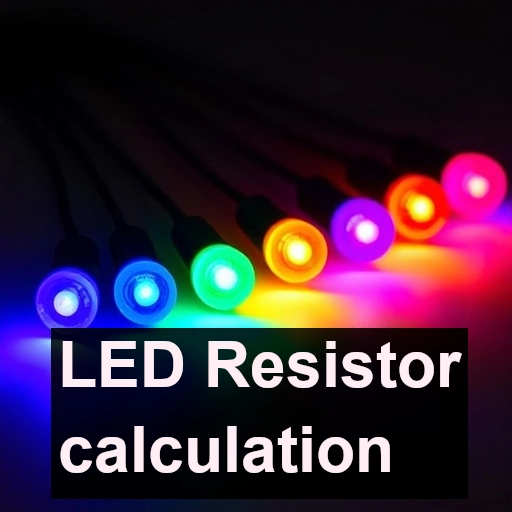LEDs (Light Emitting Diodes) are widely used for lighting, indicators, displays, and many other applications because they are energy-efficient, long-lasting, and versatile. However, to use an LED safely and efficiently in an electrical circuit, it’s important to calculate and use the right resistor to protect the LED from excessive current.
In this article, we will discuss why resistors are needed for LEDs, how to calculate the appropriate resistor value, and provide a step-by-step guide for doing so.
Why Do LEDs Need Resistors?
Unlike regular bulbs, LEDs are current-driven devices. This means they require a specific amount of current to operate properly. If too much current flows through an LED, it can overheat, get damaged, or even burn out. Resistors are used to limit the amount of current that flows through the LED, ensuring its longevity and efficient performance.
Key Factors to Consider
To calculate the proper resistor for an LED, you need to know a few key pieces of information:
- LED Forward Voltage (Vf): This is the voltage drop across the LED when it is operating. It varies depending on the color and type of LED. For example, red LEDs typically have a forward voltage of around 1.8V to 2.2V, while blue or white LEDs may have a forward voltage around 3.0V to 3.5V.
- Supply Voltage (Vs): This is the voltage of the power source you are using, such as a battery or power supply. Common values are 3V, 5V, or 12V.
- LED Current (If): This is the current required by the LED to operate safely. Most standard LEDs require around 10-20mA (milliamps) of current, but you should always check the manufacturer’s datasheet for your specific LED.
The Formula for LED Resistor Calculation
To determine the correct resistor value, we use Ohm’s Law, which states:
$$ R=\frac{Vs\;-\;Vi}{If}$$
Where:
- R = Resistor value in ohms (Ω)
- Vs= Supply voltage (volts, V)
- Vf= LED forward voltage (volts, V)
- If = LED current (amperes, A)
Let’s break down each component of the formula:
- Vs – Vf : This is the voltage difference between the supply voltage and the LED’s forward voltage. It tells you how much voltage needs to be “dropped” across the resistor to limit the current.
- If = This is the current you want to flow through the LED, typically specified in the LED’s datasheet.
Step-by-Step Guide to LED Resistor Calculation
Example 1: Using a 5V Power Supply with a Red LED
Let’s walk through an example of calculating the resistor value for a red LED with a 5V power supply.
Given:
- Supply Voltage (Vs) : 5v
- LED Forward Voltage (Vf): 2V (for a red LED)
- LED Current(If) = 20mA(0.02A)
Step 1: Calculate the voltage to be dropped across the resistor:
$$Vs\;-\:Vf\;=\;5v\;-\;2v\;=\;3v$$
Step 2: Use Ohm’s Law to calculate the resistor value:
$$R\;=\;\frac{3v}{0.02A}\;=\;150$$
So, the required resistor value for this setup is 150 ohms.
Example 2: Using a 12V Power Supply with a Blue LED
Now, let’s calculate the resistor for a blue LED with a 12V power supply.
Given:
- Supply Voltage (Vs) : 12v
- LED Forward Voltage (Vf): 3.3V (typically for a blue LED)
- LED Current(If) = 20mA(0.02A)
Step 1: Calculate the voltage to be dropped across the resistor:
$$Vs\;-\:Vf\;=\;12v\;-\;3.3v\;=\;8.7v$$
Step 2: Use Ohm’s Law to calculate the resistor value:
$$R\;=\;\frac{8.7v}{0.02A}\;=\;435$$
In this case, you would use a 435-ohm resistor. Since standard resistor values are in increments based on the E12 or E24 series, the closest available standard resistor value would be either 430 ohms or 470 ohms.
Choosing Resistor Power Rating
In addition to selecting the right resistance value, it is important to ensure that the resistor can handle the power dissipated in the circuit. The power dissipated by the resistor can be calculated using the formula:
$$P\;=\;\;I^{2\;}\;\times\;R$$
Where:
- P = Power dissipation (watts, W)
- I = Current through the resistor (amps, A)
- R = Resistor value (ohms, Ω)
Let’s calculate the power dissipation for our previous example with a 150-ohm resistor and 20mA current.
$$P\;=\;\;{(0.02A)}^2\;\times\;150\;ohm\;=\;0.0004\;\times\;150\;=\;0.06W$$
Since most resistors have a ¼ watt (0.25W) power rating, a standard ¼-watt resistor will work just fine in this case. For higher currents or larger resistors, you might need to choose a resistor with a higher power rating.
Tips and Best Practices
- Safety margin: Always choose a resistor with a slightly higher power rating than calculated to avoid overheating or potential damage.
- Standard resistor values: If your calculated resistor value is not available, select the closest standard value. Resistor values are typically chosen from the E12 or E24 series.
- Use a multimeter: If you’re unsure about the LED’s specifications, you can measure the voltage drop across the LED using a multimeter and adjust your calculations accordingly.
- Parallel and series circuits: If you’re connecting multiple LEDs, remember that the resistor calculation changes depending on whether the LEDs are in series or parallel. For LEDs in series, the total forward voltage is the sum of the individual LEDs’ voltages, while for parallel configurations, the voltage across each LED is the same.
Conclusion
Calculating the correct resistor value for an LED is a simple yet crucial task to ensure that your LED operates efficiently and safely. By following the steps outlined above, you can protect your LEDs from excessive current, extend their lifespan, and optimize their performance.
Whether you’re working on a simple DIY project or designing a more complex electronic circuit, understanding how to calculate the proper resistor for an LED is a foundational skill every electronics enthusiast should have.

